Plowback and dividend payout ratios Your company has

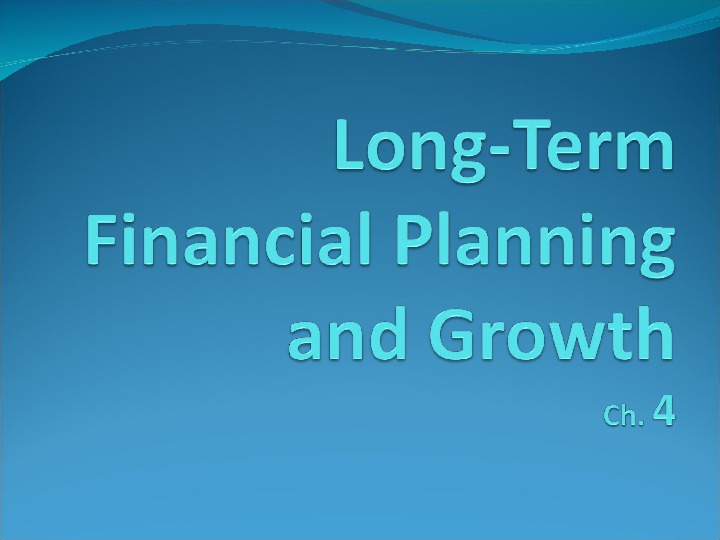
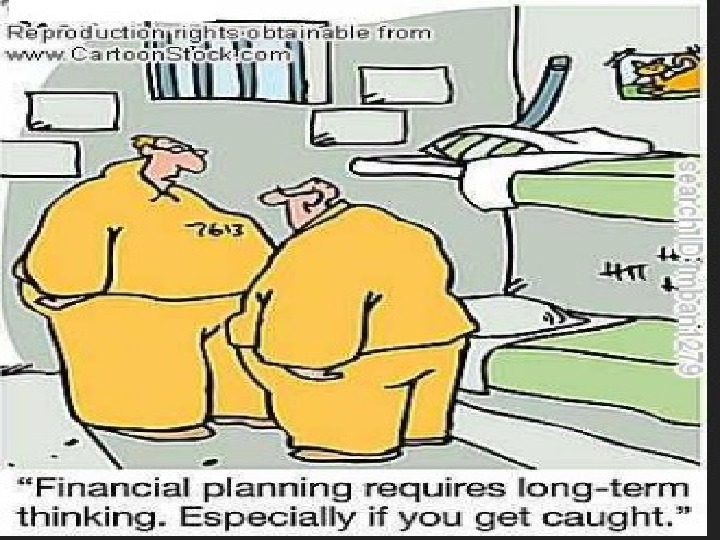
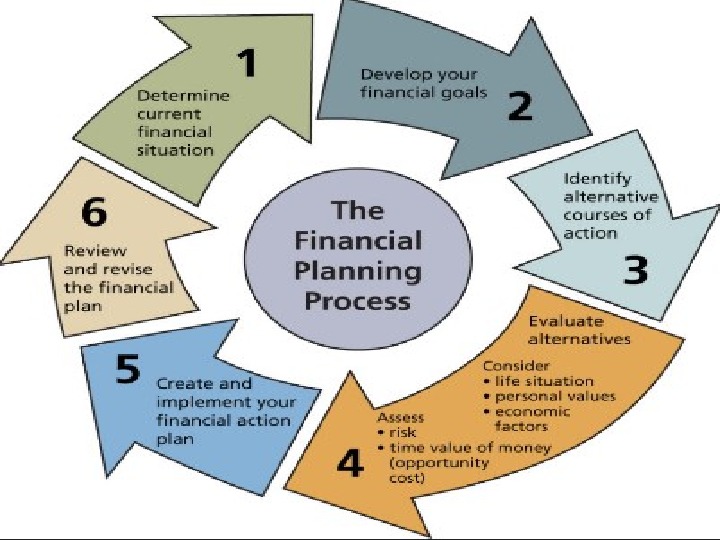
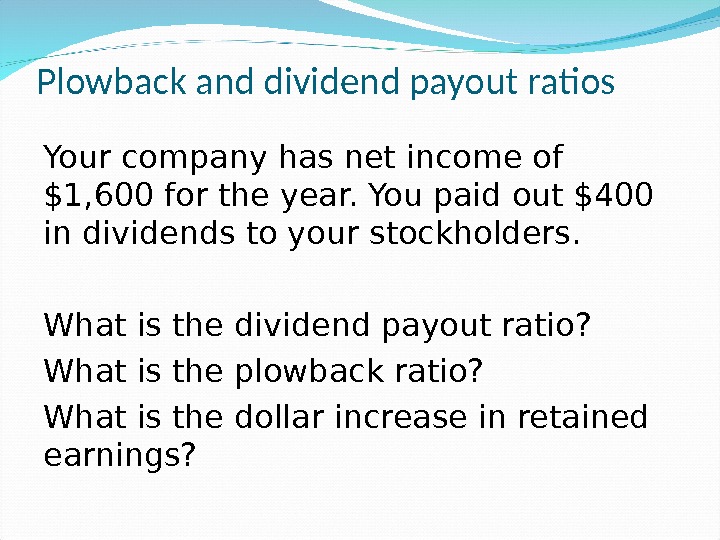
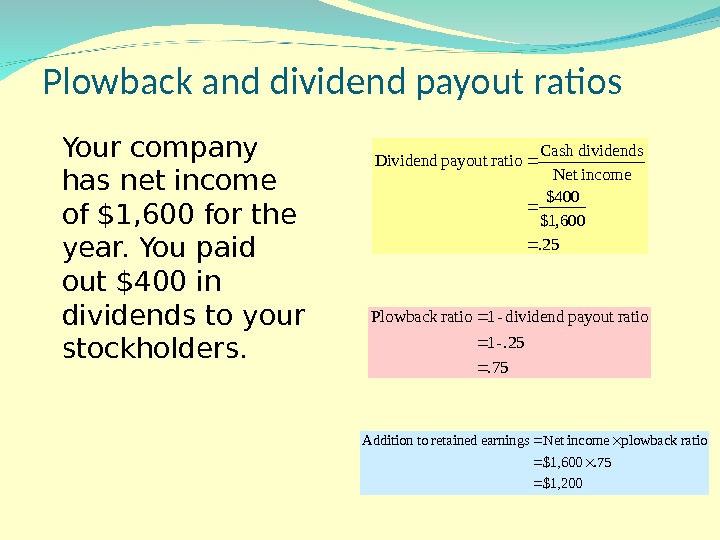
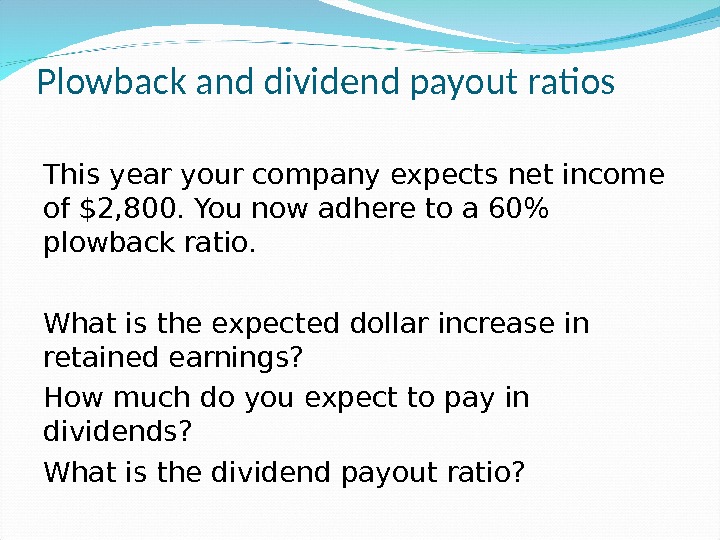
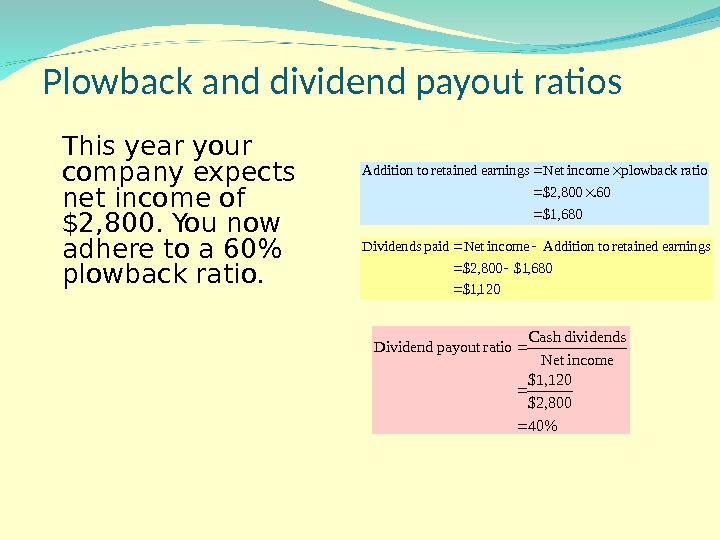
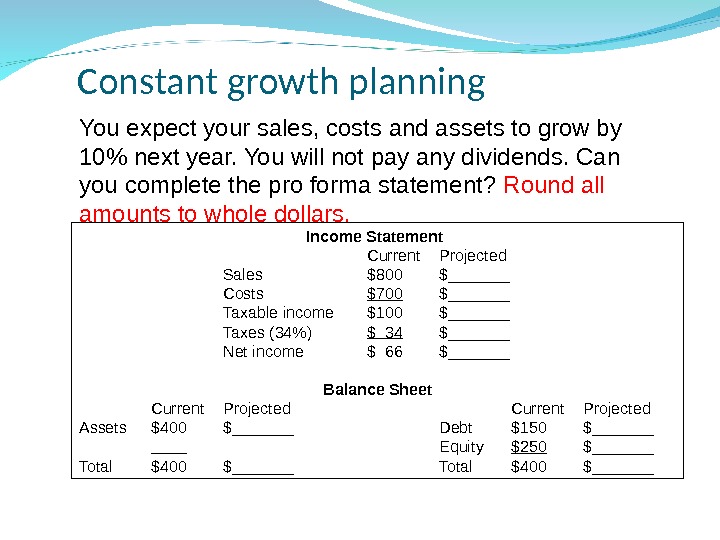
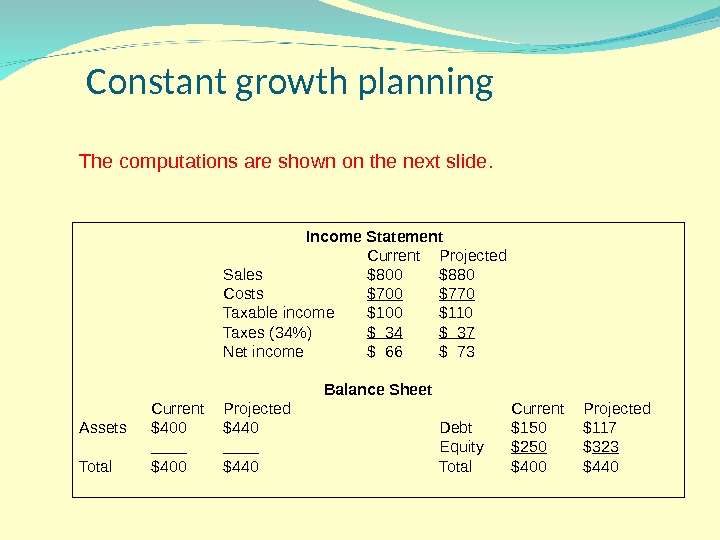
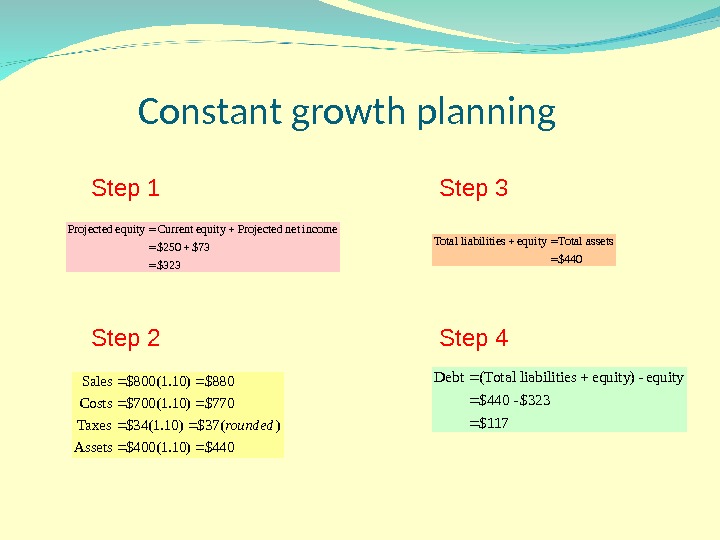
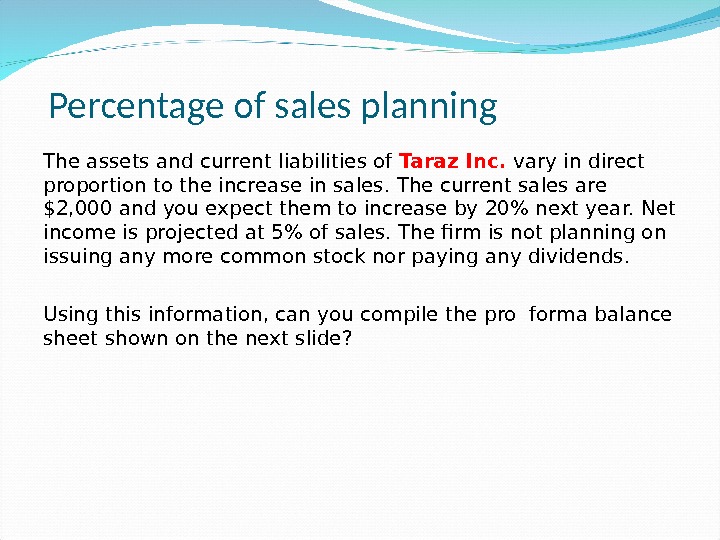
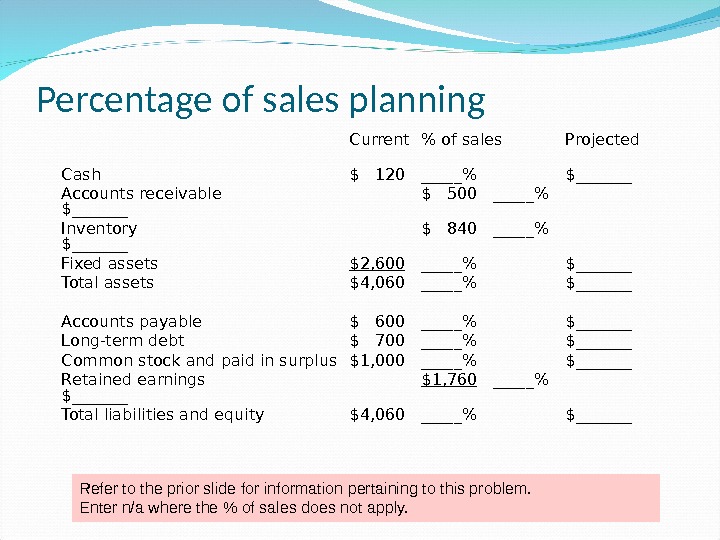
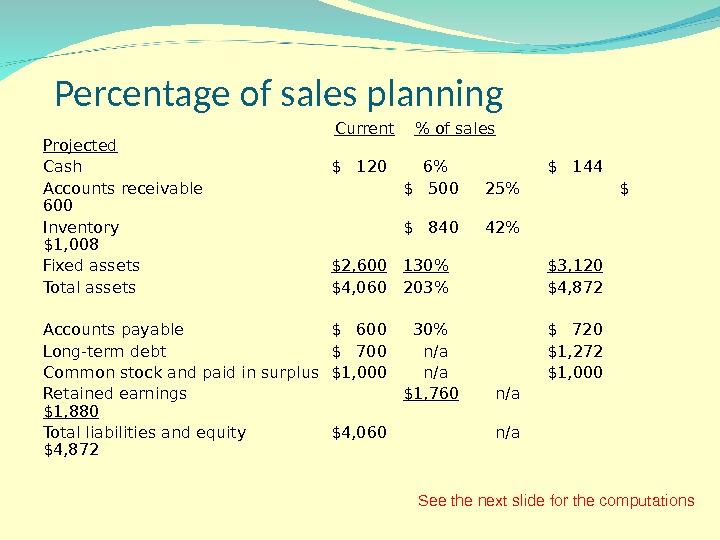
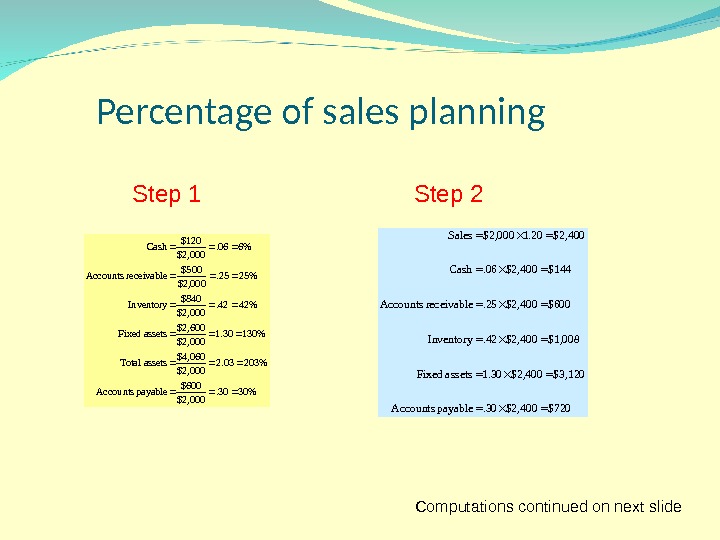
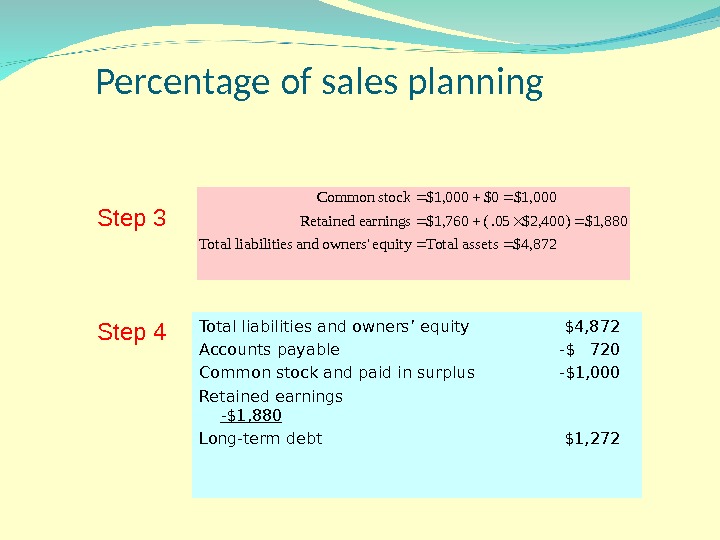
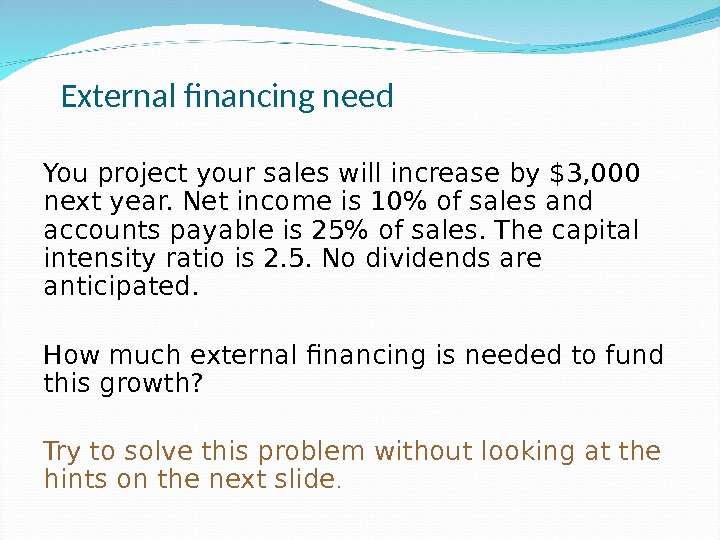
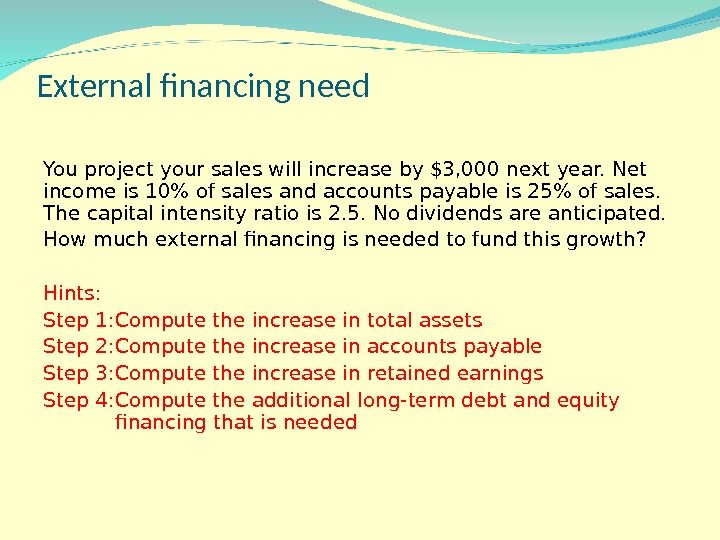
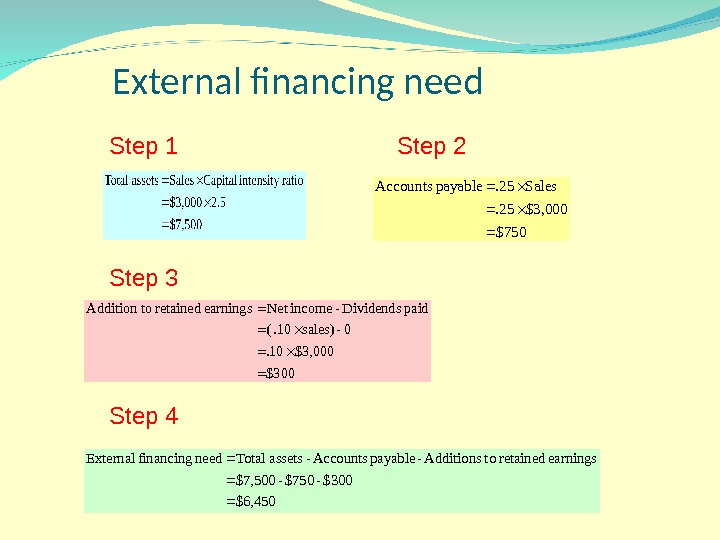
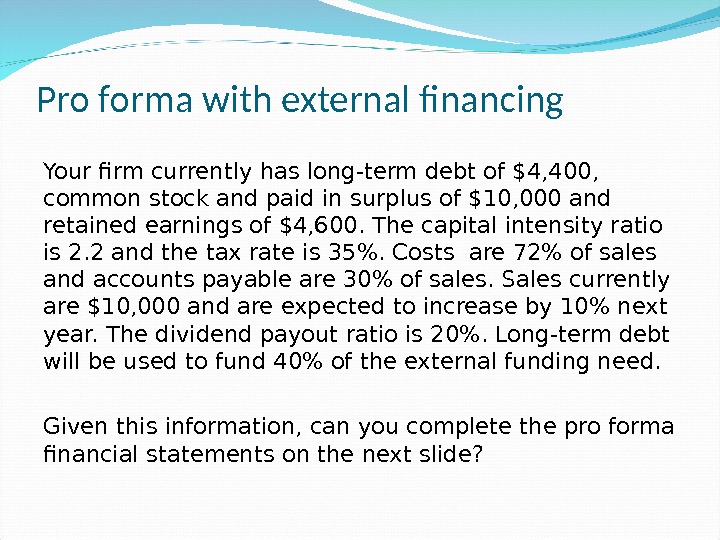
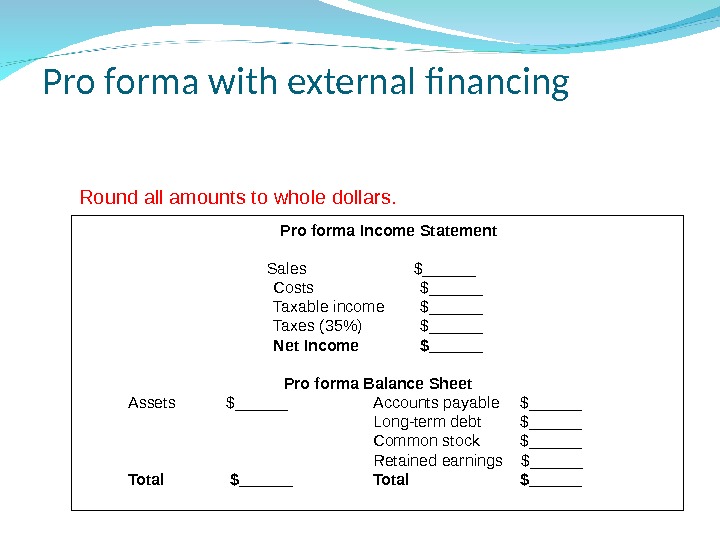
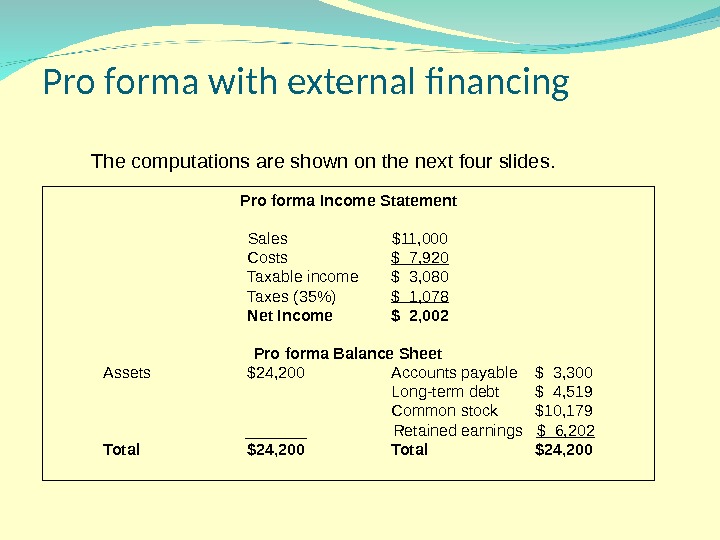
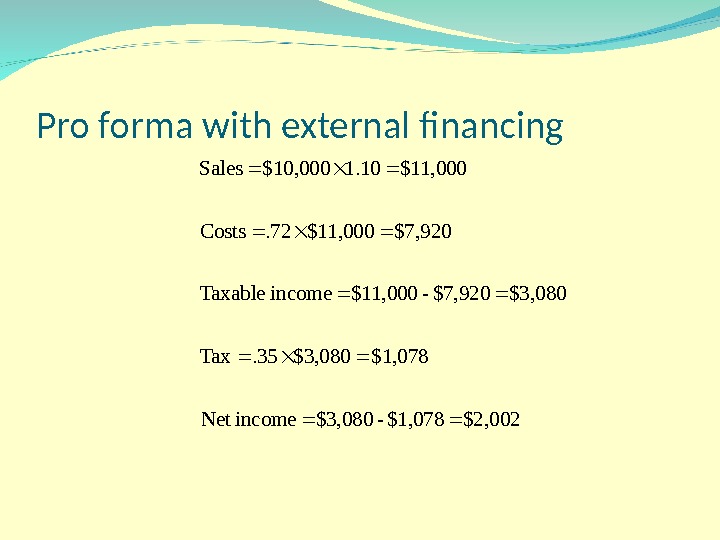
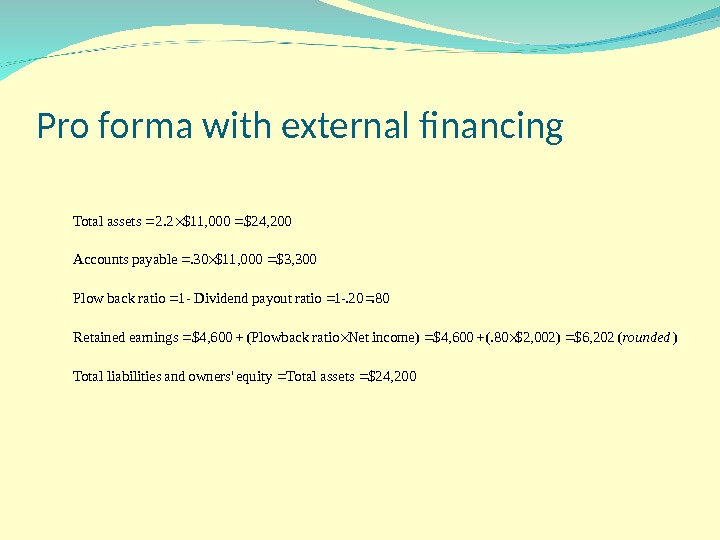
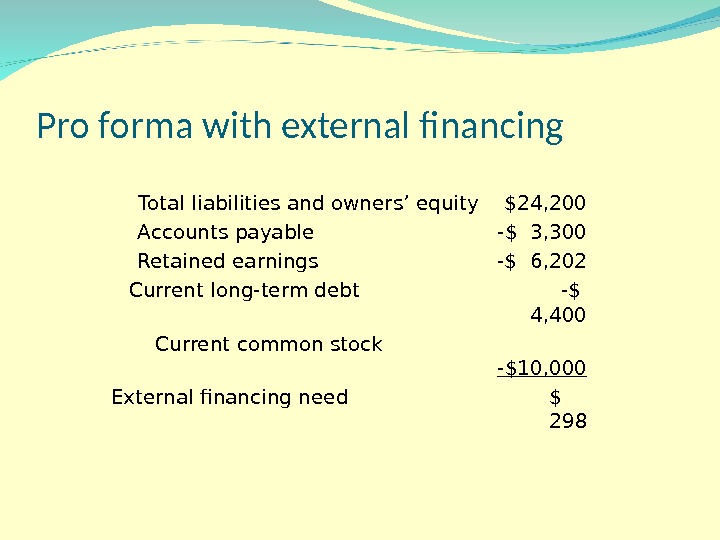
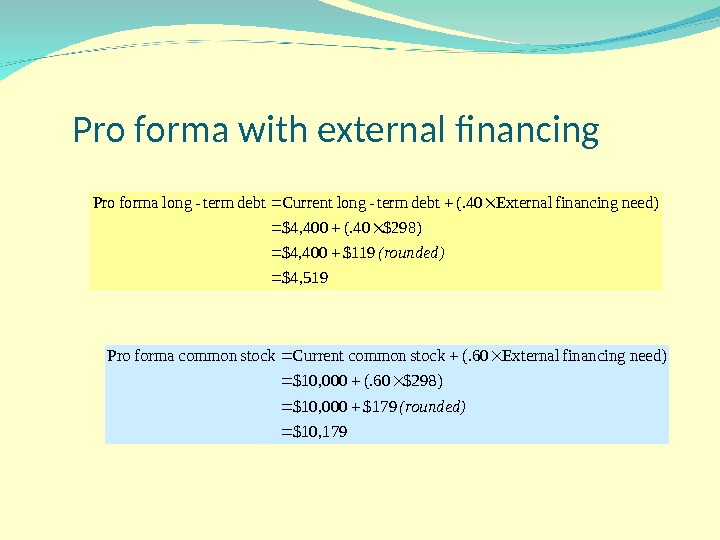
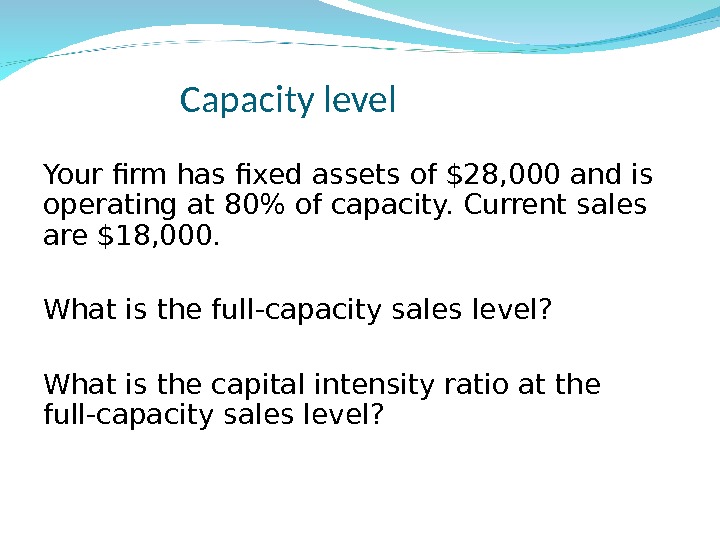
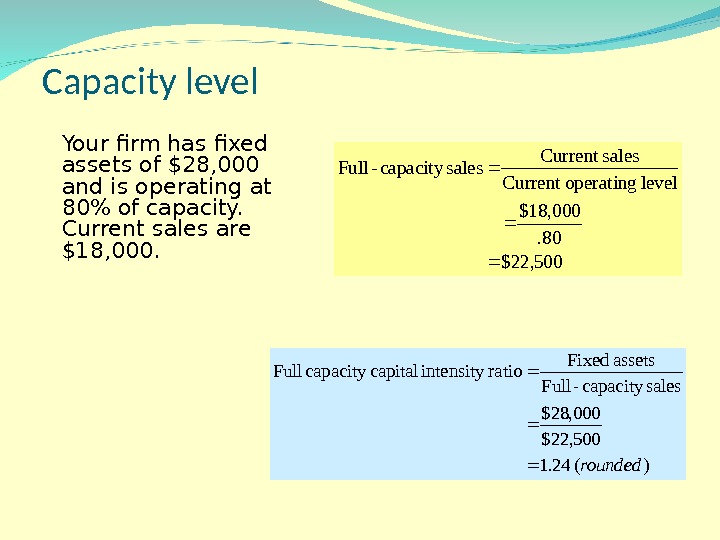
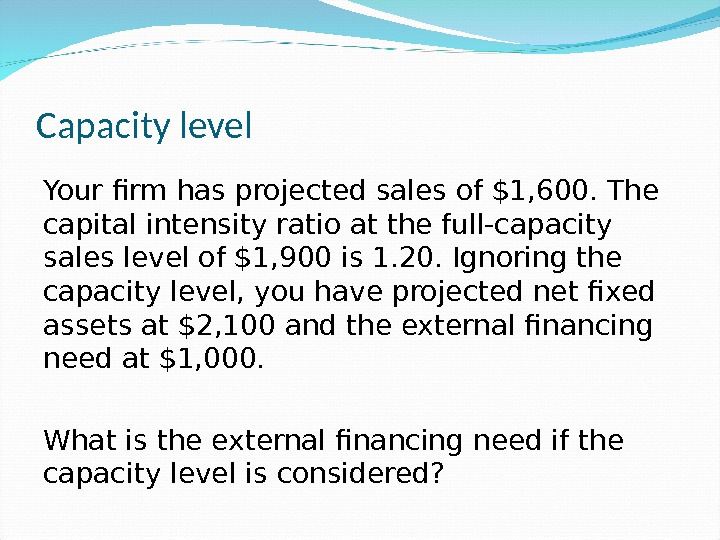

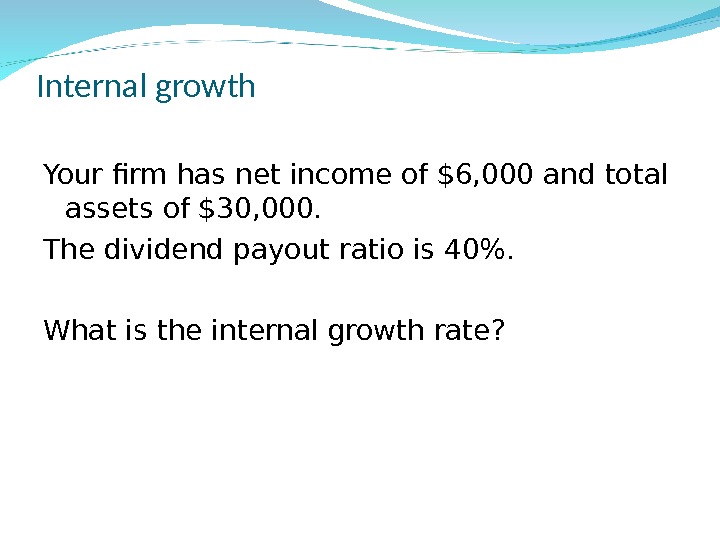
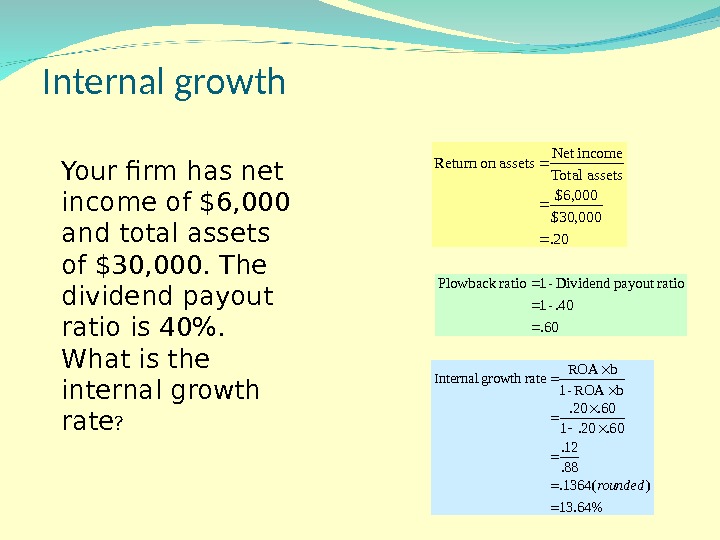
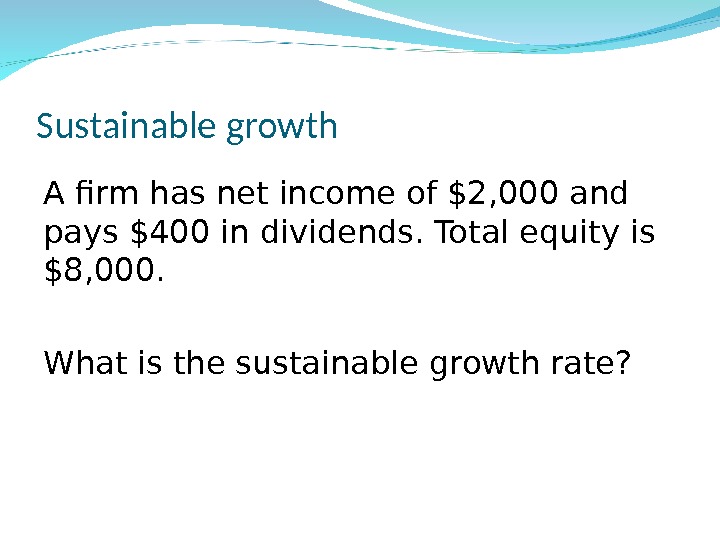
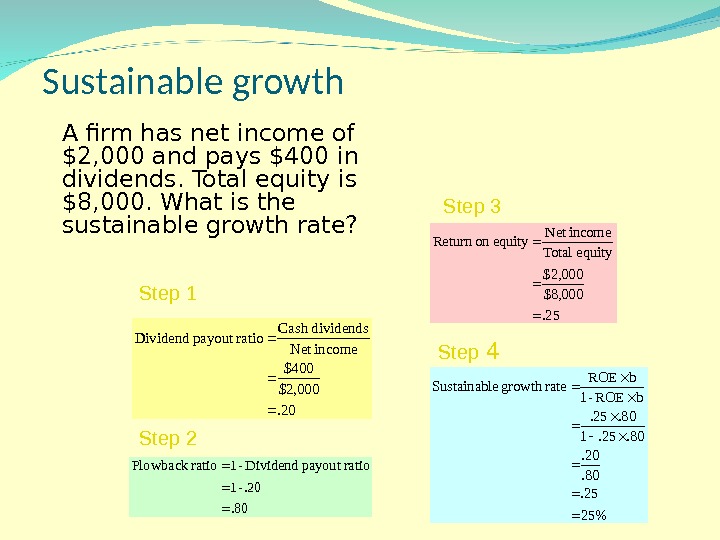
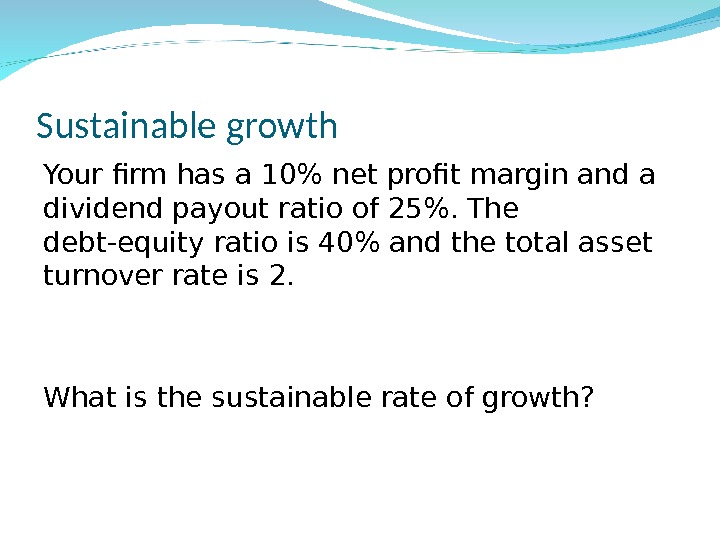
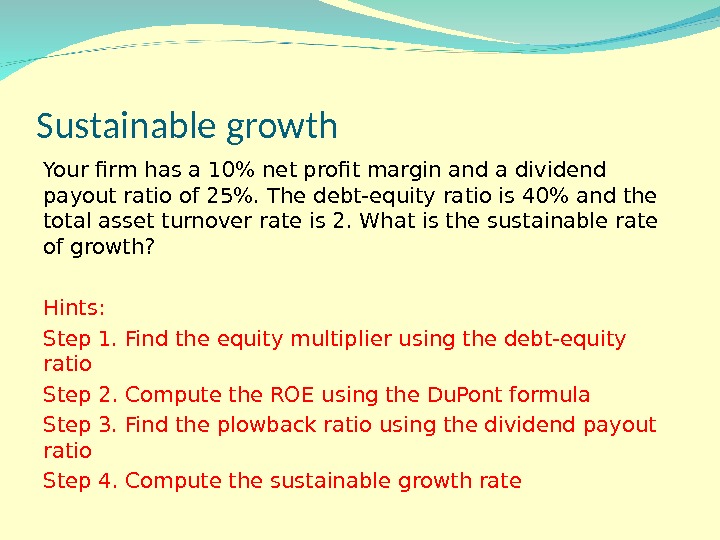
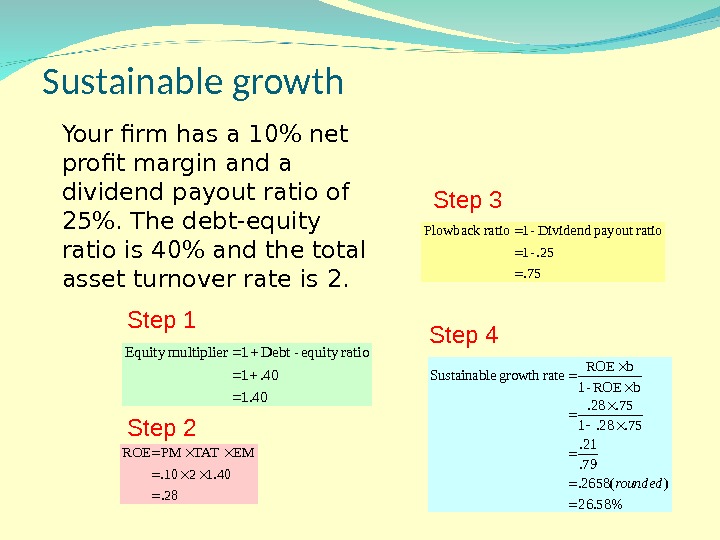

4._financial_planning_and_growth.ppt
- Размер: 1.4 Mегабайта
- Количество слайдов: 37
Описание презентации Plowback and dividend payout ratios Your company has по слайдам



 Plowback and dividend payout ratios Your company has net income of $1, 600 for the year. You paid out $400 in dividends to your stockholders. What is the dividend payout ratio? What is the plowback ratio? What is the dollar increase in retained earnings?
Plowback and dividend payout ratios Your company has net income of $1, 600 for the year. You paid out $400 in dividends to your stockholders. What is the dividend payout ratio? What is the plowback ratio? What is the dollar increase in retained earnings?
 Plowback and dividend payout ratios Your company has net income of $1, 600 for the year. You paid out $400 in dividends to your stockholders. 25. 600, 1$ 400$ income. Net dividends. Cash ratiopayout Dividend . 75 . 25 -1 ratiopayout dividend — 1 ratio. Plowback $1, 200 . 75 $1, 600 ratioplowback income. Net earnings retained o. Addition t
Plowback and dividend payout ratios Your company has net income of $1, 600 for the year. You paid out $400 in dividends to your stockholders. 25. 600, 1$ 400$ income. Net dividends. Cash ratiopayout Dividend . 75 . 25 -1 ratiopayout dividend — 1 ratio. Plowback $1, 200 . 75 $1, 600 ratioplowback income. Net earnings retained o. Addition t
 Plowback and dividend payout ratios This year your company expects net income of $2, 800. You now adhere to a 60% plowback ratio. What is the expected dollar increase in retained earnings? How much do you expect to pay in dividends? What is the dividend payout ratio?
Plowback and dividend payout ratios This year your company expects net income of $2, 800. You now adhere to a 60% plowback ratio. What is the expected dollar increase in retained earnings? How much do you expect to pay in dividends? What is the dividend payout ratio?
 Plowback and dividend payout ratios This year your company expects net income of $2, 800. You now adhere to a 60% plowback ratio. 120, 1$ 680, 1$800, 2$ earnings retained o. Addition t income. Net paid Dividends 40% $2, 800$1, 120 income. Net dividends. Cash ratiopayout Dividend $1, 680 . 60$2, 800 ratioplowback income. Net earnings retained o. Addition t
Plowback and dividend payout ratios This year your company expects net income of $2, 800. You now adhere to a 60% plowback ratio. 120, 1$ 680, 1$800, 2$ earnings retained o. Addition t income. Net paid Dividends 40% $2, 800$1, 120 income. Net dividends. Cash ratiopayout Dividend $1, 680 . 60$2, 800 ratioplowback income. Net earnings retained o. Addition t
 Constant growth planning Income Statement Current Projected Sales $800 $_______ Costs $700 $_______ Taxable income $100 $_______ Taxes (34%) $ 34 $_______ Net income $ 66 $_______ Balance Sheet Current Projected Assets $400 $_______ Debt $150 $_______ Equity $250 $_______ Total $400 $_______You expect your sales, costs and assets to grow by 10% next year. You will not pay any dividends. Can you complete the pro forma statement? Round all amounts to whole dollars.
Constant growth planning Income Statement Current Projected Sales $800 $_______ Costs $700 $_______ Taxable income $100 $_______ Taxes (34%) $ 34 $_______ Net income $ 66 $_______ Balance Sheet Current Projected Assets $400 $_______ Debt $150 $_______ Equity $250 $_______ Total $400 $_______You expect your sales, costs and assets to grow by 10% next year. You will not pay any dividends. Can you complete the pro forma statement? Round all amounts to whole dollars.
 Constant growth planning Income Statement Current Projected Sales $800 $880 Costs $700 $770 Taxable income $100 $110 Taxes (34%) $ 34 $ 37 Net income $ 66 $ 73 Balance Sheet Current Projected Assets $400 $440 Debt $150 $117 Equity $250 $ 323 Total $400 $440 The computations are shown on the next slide.
Constant growth planning Income Statement Current Projected Sales $800 $880 Costs $700 $770 Taxable income $100 $110 Taxes (34%) $ 34 $ 37 Net income $ 66 $ 73 Balance Sheet Current Projected Assets $400 $440 Debt $150 $117 Equity $250 $ 323 Total $400 $440 The computations are shown on the next slide.
 Constant growth planning $323 $73 $250 incomenet Projected equity Current equity Projected $440 assets Total equity sliabilitie Total $117 $323 — $440 equity — equity) sliabilitie (Total Debt $440 $400(1. 10) Assets )($37 $34(1. 10) Taxes $770 $700(1. 10) Costs $880 $800(1. 10) Sales rounded. Step 1 Step 2 Step 3 Step
Constant growth planning $323 $73 $250 incomenet Projected equity Current equity Projected $440 assets Total equity sliabilitie Total $117 $323 — $440 equity — equity) sliabilitie (Total Debt $440 $400(1. 10) Assets )($37 $34(1. 10) Taxes $770 $700(1. 10) Costs $880 $800(1. 10) Sales rounded. Step 1 Step 2 Step 3 Step
 Percentage of sales planning The assets and current liabilities of Taraz Inc. vary in direct proportion to the increase in sales. The current sales are $2, 000 and you expect them to increase by 20% next year. Net income is projected at 5% of sales. The firm is not planning on issuing any more common stock nor paying any dividends. Using this information, can you compile the pro forma balance sheet shown on the next slide?
Percentage of sales planning The assets and current liabilities of Taraz Inc. vary in direct proportion to the increase in sales. The current sales are $2, 000 and you expect them to increase by 20% next year. Net income is projected at 5% of sales. The firm is not planning on issuing any more common stock nor paying any dividends. Using this information, can you compile the pro forma balance sheet shown on the next slide?
 Percentage of sales planning Current % of sales Projected Cash $ 120 _____% $_______ Accounts receivable $ 500 _____% $_______ Inventory $ 840 _____% $_______ Fixed assets $2, 600 _____% $_______ Total assets $4, 060 _____% $_______ Accounts payable $ 600 _____% $_______ Long-term debt $ 700 _____% $_______ Common stock and paid in surplus $1, 000 _____% $_______ Retained earnings $1, 760 _____% $_______ Total liabilities and equity $4, 060 _____% $_______ Refer to the prior slide for information pertaining to this problem. Enter n/a where the % of sales does not apply.
Percentage of sales planning Current % of sales Projected Cash $ 120 _____% $_______ Accounts receivable $ 500 _____% $_______ Inventory $ 840 _____% $_______ Fixed assets $2, 600 _____% $_______ Total assets $4, 060 _____% $_______ Accounts payable $ 600 _____% $_______ Long-term debt $ 700 _____% $_______ Common stock and paid in surplus $1, 000 _____% $_______ Retained earnings $1, 760 _____% $_______ Total liabilities and equity $4, 060 _____% $_______ Refer to the prior slide for information pertaining to this problem. Enter n/a where the % of sales does not apply.
 Percentage of sales planning Current % of sales Projected Cash $ 120 6% $ 144 Accounts receivable $ 500 25% $ 600 Inventory $ 840 42% $1, 008 Fixed assets $2, 600 130% $3, 120 Total assets $4, 060 203% $4, 872 Accounts payable $ 600 30% $ 720 Long-term debt $ 700 n/a $1, 272 Common stock and paid in surplus $1, 000 n/a $1, 000 Retained earnings $1, 760 n/a $1, 880 Total liabilities and equity $4, 060 n/a $4, 872 See the next slide for the computations
Percentage of sales planning Current % of sales Projected Cash $ 120 6% $ 144 Accounts receivable $ 500 25% $ 600 Inventory $ 840 42% $1, 008 Fixed assets $2, 600 130% $3, 120 Total assets $4, 060 203% $4, 872 Accounts payable $ 600 30% $ 720 Long-term debt $ 700 n/a $1, 272 Common stock and paid in surplus $1, 000 n/a $1, 000 Retained earnings $1, 760 n/a $1, 880 Total liabilities and equity $4, 060 n/a $4, 872 See the next slide for the computations
 Percentage of sales planning %3030. $2, 000 $600 payable Accounts %20303. 2 $2, 000$4, 060 assets Total %13030. 1 $2, 000$2, 600 assets Fixed %4242. $2, 000 $840 Inventory %2525. $2, 000 $500 receivable Accounts %606. $2, 000 $120 Cash $720 $2, 400. 30 payable Accounts $3, 120 $2, 4001. 30 assets Fixed $1, 008 $2, 400. 42 Inventory $600 $2, 400. 25 receivable Accounts $144 $2, 400. 06 Cash $2, 400 1. 20$2, 000 Sales Step 1 Step 2 Computations continued on next slide
Percentage of sales planning %3030. $2, 000 $600 payable Accounts %20303. 2 $2, 000$4, 060 assets Total %13030. 1 $2, 000$2, 600 assets Fixed %4242. $2, 000 $840 Inventory %2525. $2, 000 $500 receivable Accounts %606. $2, 000 $120 Cash $720 $2, 400. 30 payable Accounts $3, 120 $2, 4001. 30 assets Fixed $1, 008 $2, 400. 42 Inventory $600 $2, 400. 25 receivable Accounts $144 $2, 400. 06 Cash $2, 400 1. 20$2, 000 Sales Step 1 Step 2 Computations continued on next slide
 Percentage of sales planning $4, 872 assets Total equity owners’ and sliabilitie Total $1, 880 $2, 400). 05 ( $1, 760 earnings Retained $1, 000 $0 $1, 000 stock Common Total liabilities and owners’ equity $4, 872 Accounts payable -$ 720 Common stock and paid in surplus -$1, 000 Retained earnings -$1, 880 Long-term debt $1, 272 Step 3 Step
Percentage of sales planning $4, 872 assets Total equity owners’ and sliabilitie Total $1, 880 $2, 400). 05 ( $1, 760 earnings Retained $1, 000 $0 $1, 000 stock Common Total liabilities and owners’ equity $4, 872 Accounts payable -$ 720 Common stock and paid in surplus -$1, 000 Retained earnings -$1, 880 Long-term debt $1, 272 Step 3 Step
 External financing need You project your sales will increase by $3, 000 next year. Net income is 10% of sales and accounts payable is 25% of sales. The capital intensity ratio is 2. 5. No dividends are anticipated. How much external financing is needed to fund this growth? Try to solve this problem without looking at the hints on the next slide.
External financing need You project your sales will increase by $3, 000 next year. Net income is 10% of sales and accounts payable is 25% of sales. The capital intensity ratio is 2. 5. No dividends are anticipated. How much external financing is needed to fund this growth? Try to solve this problem without looking at the hints on the next slide.
 External financing need You project your sales will increase by $3, 000 next year. Net income is 10% of sales and accounts payable is 25% of sales. The capital intensity ratio is 2. 5. No dividends are anticipated. How much external financing is needed to fund this growth? Hints: Step 1: Compute the increase in total assets Step 2: Compute the increase in accounts payable Step 3: Compute the increase in retained earnings Step 4: Compute the additional long-term debt and equity financing that is needed
External financing need You project your sales will increase by $3, 000 next year. Net income is 10% of sales and accounts payable is 25% of sales. The capital intensity ratio is 2. 5. No dividends are anticipated. How much external financing is needed to fund this growth? Hints: Step 1: Compute the increase in total assets Step 2: Compute the increase in accounts payable Step 3: Compute the increase in retained earnings Step 4: Compute the additional long-term debt and equity financing that is needed
 External financing need $750 $3, 000. 25 Sales. 25 payable Accounts Step 2 Step 3$300 $3, 000. 10 0 -sales). 10 ( paid Dividends — income. Net earnings retained o. Addition t Step 4 $6, 450 $300 — $750 — $7, 500 earnings retained to. Additions — payable Accounts — assets Total need financing External Step
External financing need $750 $3, 000. 25 Sales. 25 payable Accounts Step 2 Step 3$300 $3, 000. 10 0 -sales). 10 ( paid Dividends — income. Net earnings retained o. Addition t Step 4 $6, 450 $300 — $750 — $7, 500 earnings retained to. Additions — payable Accounts — assets Total need financing External Step
 Pro forma with external financing Your firm currently has long-term debt of $4, 400, common stock and paid in surplus of $10, 000 and retained earnings of $4, 600. The capital intensity ratio is 2. 2 and the tax rate is 35%. Costs are 72% of sales and accounts payable are 30% of sales. Sales currently are $10, 000 and are expected to increase by 10% next year. The dividend payout ratio is 20%. Long-term debt will be used to fund 40% of the external funding need. Given this information, can you complete the pro forma financial statements on the next slide?
Pro forma with external financing Your firm currently has long-term debt of $4, 400, common stock and paid in surplus of $10, 000 and retained earnings of $4, 600. The capital intensity ratio is 2. 2 and the tax rate is 35%. Costs are 72% of sales and accounts payable are 30% of sales. Sales currently are $10, 000 and are expected to increase by 10% next year. The dividend payout ratio is 20%. Long-term debt will be used to fund 40% of the external funding need. Given this information, can you complete the pro forma financial statements on the next slide?
 Pro forma with external financing Pro forma Income Statement Sales $______ Costs $______ Taxable income $______ Taxes (35%) $______ Net Income $______ Pro forma Balance Sheet Assets $______ Accounts payable $______ Long-term debt $______ Common stock $______ Retained earnings $______ Total $______Round all amounts to whole dollars.
Pro forma with external financing Pro forma Income Statement Sales $______ Costs $______ Taxable income $______ Taxes (35%) $______ Net Income $______ Pro forma Balance Sheet Assets $______ Accounts payable $______ Long-term debt $______ Common stock $______ Retained earnings $______ Total $______Round all amounts to whole dollars.
 Pro forma with external financing Pro forma Income Statement Sales $11, 000 Costs $ 7, 920 Taxable income $ 3, 080 Taxes (35%) $ 1, 078 Net Income $ 2, 002 Pro forma Balance Sheet Assets $24, 200 Accounts payable $ 3, 300 Long-term debt $ 4, 519 Common stock $10, 179 _______ Retained earnings $ 6, 202 Total $24, 200 The computations are shown on the next four slides.
Pro forma with external financing Pro forma Income Statement Sales $11, 000 Costs $ 7, 920 Taxable income $ 3, 080 Taxes (35%) $ 1, 078 Net Income $ 2, 002 Pro forma Balance Sheet Assets $24, 200 Accounts payable $ 3, 300 Long-term debt $ 4, 519 Common stock $10, 179 _______ Retained earnings $ 6, 202 Total $24, 200 The computations are shown on the next four slides.
 Pro forma with external financing $2, 002 $1, 078 — $3, 080 income. Net $1, 078$3, 080. 35 Tax $3, 080 $7, 920 — $11, 000 income Taxable $7, 920 $11, 000. 72 Costs $11, 000 1. 10$10, 000 Sales
Pro forma with external financing $2, 002 $1, 078 — $3, 080 income. Net $1, 078$3, 080. 35 Tax $3, 080 $7, 920 — $11, 000 income Taxable $7, 920 $11, 000. 72 Costs $11, 000 1. 10$10, 000 Sales
 Pro forma with external financing $24, 200 assets Total equity owners’ and sliabilitie Total )( $6, 202 $2, 002)(. 80 $4, 600 income)Net ratio(Plowback $4, 600 earnings Retained. 80. 20 -1 ratiopayout Dividend — 1 ratioback Plow $3, 300 $11, 000. 30 payable Accounts $24, 200 $11, 0002. 2 assets Total rounded
Pro forma with external financing $24, 200 assets Total equity owners’ and sliabilitie Total )( $6, 202 $2, 002)(. 80 $4, 600 income)Net ratio(Plowback $4, 600 earnings Retained. 80. 20 -1 ratiopayout Dividend — 1 ratioback Plow $3, 300 $11, 000. 30 payable Accounts $24, 200 $11, 0002. 2 assets Total rounded
 Pro forma with external financing Total liabilities and owners’ equity $24, 200 Accounts payable -$ 3, 300 Retained earnings -$ 6, 202 Current long-term debt -$ 4, 400 Current common stock -$10, 000 External financing need $
Pro forma with external financing Total liabilities and owners’ equity $24, 200 Accounts payable -$ 3, 300 Retained earnings -$ 6, 202 Current long-term debt -$ 4, 400 Current common stock -$10, 000 External financing need $
 Pro forma with external financing $4, 519 $119 $4, 400 $298)(. 40 $4, 400 need) financing External(. 40 debt term-long. Current debt term-long forma Pro (rounded) $10, 179 $10, 000 $298)(. 60 $10, 000 need) financing External(. 60 stock common Current stock common forma Pro (rounded)
Pro forma with external financing $4, 519 $119 $4, 400 $298)(. 40 $4, 400 need) financing External(. 40 debt term-long. Current debt term-long forma Pro (rounded) $10, 179 $10, 000 $298)(. 60 $10, 000 need) financing External(. 60 stock common Current stock common forma Pro (rounded)
 Capacity level Your firm has fixed assets of $28, 000 and is operating at 80% of capacity. Current sales are $18, 000. What is the full-capacity sales level? What is the capital intensity ratio at the full-capacity sales level?
Capacity level Your firm has fixed assets of $28, 000 and is operating at 80% of capacity. Current sales are $18, 000. What is the full-capacity sales level? What is the capital intensity ratio at the full-capacity sales level?
 Capacity level Your firm has fixed assets of $28, 000 and is operating at 80% of capacity. Current sales are $18, 000. 500, 22$. 80$18, 000 level operating. Current sales. Current salescapacity -Full )( 24. 1 500, 22$ 000, 28$ salescapacity -Full assets Fixed ratiointensity capitalcapacity Full rounded
Capacity level Your firm has fixed assets of $28, 000 and is operating at 80% of capacity. Current sales are $18, 000. 500, 22$. 80$18, 000 level operating. Current sales. Current salescapacity -Full )( 24. 1 500, 22$ 000, 28$ salescapacity -Full assets Fixed ratiointensity capitalcapacity Full rounded
 Capacity level Your firm has projected sales of $1, 600. The capital intensity ratio at the full-capacity sales level of $1, 900 is 1. 20. Ignoring the capacity level, you have projected net fixed assets at $2, 100 and the external financing need at $1, 000. What is the external financing need if the capacity level is considered?
Capacity level Your firm has projected sales of $1, 600. The capital intensity ratio at the full-capacity sales level of $1, 900 is 1. 20. Ignoring the capacity level, you have projected net fixed assets at $2, 100 and the external financing need at $1, 000. What is the external financing need if the capacity level is considered?
 Capacity level Your firm has projected sales of $1, 600. The capital intensity ratio at the full-capacity sales level of $1, 900 is 1. 20. Ignoring the capacity level, you have projected net fixed assets at $2, 100 and the external financing need at $1, 000. What is the external financing need if the capacity level is considered? $1, 920 1. 2$1, 600 ratiointensity Capital Sales needed assets Fixed $180 $1, 920 — $2, 100 needed assets Fixed — projected assets Fixed estimate Excess $820 $180 — $1, 000 estimate Excess — need financing external Projected need financing external Actual
Capacity level Your firm has projected sales of $1, 600. The capital intensity ratio at the full-capacity sales level of $1, 900 is 1. 20. Ignoring the capacity level, you have projected net fixed assets at $2, 100 and the external financing need at $1, 000. What is the external financing need if the capacity level is considered? $1, 920 1. 2$1, 600 ratiointensity Capital Sales needed assets Fixed $180 $1, 920 — $2, 100 needed assets Fixed — projected assets Fixed estimate Excess $820 $180 — $1, 000 estimate Excess — need financing external Projected need financing external Actual
 Internal growth Your firm has net income of $6, 000 and total assets of $30, 000. The dividend payout ratio is 40%. What is the internal growth rate?
Internal growth Your firm has net income of $6, 000 and total assets of $30, 000. The dividend payout ratio is 40%. What is the internal growth rate?
 Internal growth Your firm has net income of $6, 000 and total assets of $30, 000. The dividend payout ratio is 40%. What is the internal growth rate ? 20. 000, 30$ 000, 6$ assets Total income. Net assetson Return . 60. 40 — 1 ratiopayout Dividend — 1 ratio. Plowback %64. 13 )(1364. 88. 12. 60. 20. 1 60. 20. b. ROA-1 b. ROA rategrowth Internal rounded
Internal growth Your firm has net income of $6, 000 and total assets of $30, 000. The dividend payout ratio is 40%. What is the internal growth rate ? 20. 000, 30$ 000, 6$ assets Total income. Net assetson Return . 60. 40 — 1 ratiopayout Dividend — 1 ratio. Plowback %64. 13 )(1364. 88. 12. 60. 20. 1 60. 20. b. ROA-1 b. ROA rategrowth Internal rounded
 Sustainable growth A firm has net income of $2, 000 and pays $400 in dividends. Total equity is $8, 000. What is the sustainable growth rate?
Sustainable growth A firm has net income of $2, 000 and pays $400 in dividends. Total equity is $8, 000. What is the sustainable growth rate?
 Sustainable growth A firm has net income of $2, 000 and pays $400 in dividends. Total equity is $8, 000. What is the sustainable growth rate? 20. 000, 2$ 400$ income. Net dividends. Cash ratiopayout Dividend . 80. 20 -1 ratiopayout Dividend — 1 ratio. Plowback 25. 000, 8$ 000, 2$ equity Total income. Net equity on Return %25 25. 80. 20. 80. 25. 1 80. 25. b. ROE-1 b. ROE rategrowth e. Sustainabl Step 1 Step 2 Step 3 Step
Sustainable growth A firm has net income of $2, 000 and pays $400 in dividends. Total equity is $8, 000. What is the sustainable growth rate? 20. 000, 2$ 400$ income. Net dividends. Cash ratiopayout Dividend . 80. 20 -1 ratiopayout Dividend — 1 ratio. Plowback 25. 000, 8$ 000, 2$ equity Total income. Net equity on Return %25 25. 80. 20. 80. 25. 1 80. 25. b. ROE-1 b. ROE rategrowth e. Sustainabl Step 1 Step 2 Step 3 Step
 Sustainable growth Your firm has a 10% net profit margin and a dividend payout ratio of 25%. The debt-equity ratio is 40% and the total asset turnover rate is 2. What is the sustainable rate of growth?
Sustainable growth Your firm has a 10% net profit margin and a dividend payout ratio of 25%. The debt-equity ratio is 40% and the total asset turnover rate is 2. What is the sustainable rate of growth?
 Sustainable growth Your firm has a 10% net profit margin and a dividend payout ratio of 25%. The debt-equity ratio is 40% and the total asset turnover rate is 2. What is the sustainable rate of growth? Hints: Step 1. Find the equity multiplier using the debt-equity ratio Step 2. Compute the ROE using the Du. Pont formula Step 3. Find the plowback ratio using the dividend payout ratio Step 4. Compute the sustainable growth rate
Sustainable growth Your firm has a 10% net profit margin and a dividend payout ratio of 25%. The debt-equity ratio is 40% and the total asset turnover rate is 2. What is the sustainable rate of growth? Hints: Step 1. Find the equity multiplier using the debt-equity ratio Step 2. Compute the ROE using the Du. Pont formula Step 3. Find the plowback ratio using the dividend payout ratio Step 4. Compute the sustainable growth rate
 Sustainable growth Your firm has a 10% net profit margin and a dividend payout ratio of 25%. The debt-equity ratio is 40% and the total asset turnover rate is 2. 1. 401 ratioequity -Debt 1 multiplier. Equity Step 1 Step 2 Step 3 Step 4 28. 40. 12. 10 EMTATPM ROE . 75. 25 -1 ratiopayout Dividend — 1 ratio. Plowback %58. 26 )(2658. 79. 21. 75. 28. 1 75. 28. b. ROE-1 b. ROE rategrowth e. Sustainabl rounded
Sustainable growth Your firm has a 10% net profit margin and a dividend payout ratio of 25%. The debt-equity ratio is 40% and the total asset turnover rate is 2. 1. 401 ratioequity -Debt 1 multiplier. Equity Step 1 Step 2 Step 3 Step 4 28. 40. 12. 10 EMTATPM ROE . 75. 25 -1 ratiopayout Dividend — 1 ratio. Plowback %58. 26 )(2658. 79. 21. 75. 28. 1 75. 28. b. ROE-1 b. ROE rategrowth e. Sustainabl rounded


